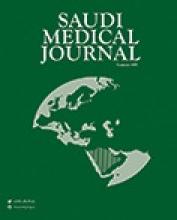Abstract
OBJECTIVE: To assess the prevalence of multi-drug resistant (MDR) bacteria causing infections in patients at the intensive care units (ICUs) of Riyadh Military Hospital (RMH), as well as their antimicrobial resistance patterns for one year.
METHODS: A retrospective, cohort investigation was performed. Laboratory records from January to December 2009 were studied for the prevalence of MDR Gram-negative and Gram-positive bacteria and their antimicrobial resistance in ICU patients from RMH, Riyadh, Kingdom of Saudi Arabia.
RESULTS: A total of 1210 isolates were collected from various specimens such as: respiratory (469), blood (400), wound/tissue (235), urinary (56), nasal swabs (35), and cerebro-spinal fluid (15). Regardless of the specimen, there was a high rate of nosocomial MDR organisms isolated from patients enrolled in the General ICU (GICU) in Riyadh. Acinetobacter baumannii (A. baumannii) comprised 40.9%, Klebsiella pneumonia (K. pneumonia) - 19.4%, while Pseudomonas aeruginosa (P. aeruginosa) formed 16.3% of these isolates.
CONCLUSION: The P. aeruginosa, A. baumannii, K. pneumoniae, Escherichia coli, Staphylococcus aureus (methycillin sensitive and methycillin resistant), and Staphylococccus coagulase negative are the most common isolates recovered from clinical specimens in the GICU of RMH. Respiratory tract specimens represented nearly 39% of all the specimens collected in the ICU. The most common MDR organisms isolated in this unit were A. baumannii, and K. pneumoniae.
- Copyright: © Saudi Medical Journal
This is an open-access article distributed under the terms of the Creative Commons Attribution-Noncommercial-Share Alike 3.0 Unported, which permits unrestricted use, distribution, and reproduction in any medium, provided the original work is properly cited.






